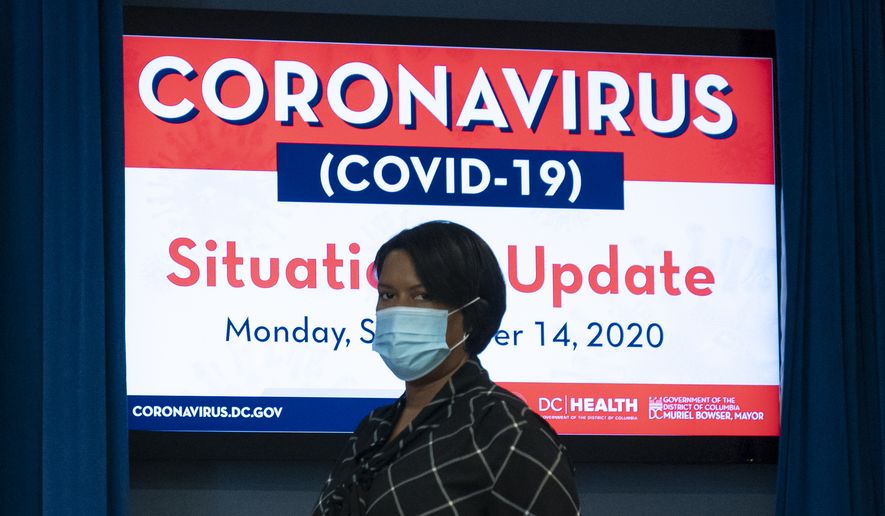D.C. Mayor Muriel Bowser announced Monday a new coronavirus contact tracing tool for smartphone users in the District.
Beginning Tuesday, residents with iPhone or Android smartphones will start receiving push notifications asking them to opt into exposure alerts for the D.C. COVID Alert Notice (DC CAN).
When the app is enabled, a users’ phone will “regularly” emit a random identification number via Bluetooth that can be picked up by other phones. The ID can change every 10-20 minutes to make sure it “cannot be used to identify users or their whereabouts,” according to the D.C. Health Department website.
The ID numbers will be stored, and if a user reports through the system that they have tested positive for the virus, other users will be notified if they were near that person within the previous 14 days.
When a user is contacted by the D.C. Contact Trace Force about a positive test result, a representative will give that person a unique, six-digit validation code to enter into the system to alert others. Officials said the names of those who test positive will not be shared.
iPhone users can enable alerts through the device settings, and Android users can download the app from the Google Play store.
“This tool will only be useful if we have widespread participation,” Health Department Director Dr. LaQuandra Nesbitt said during a coronavirus press briefing.
People also can choose to share personal information that will be used solely for public health purposes, such as a phone number for a follow-up by a contact tracer, Dr. Nesbitt said.
The DC CAN system was created by Apple and Google, and it will work outside the District in areas that use the tool and the national server created by the Association of Public Health Laboratories (APHL). The website states those areas currently include New York, New Jersey, Delaware, Pennsylvania, North Carolina, Nevada, North Dakota and Wyoming.
Virginia launched the Apple-Google exposure notification system “COVIDWISE” in August, but it does not use the APHL national server. As of Oct. 18, the app has been downloaded 677,599 times, and 320 anonymous positive results have been submitted, according to Jeff Stover, executive adviser to the Virginia health commissioner.
During the D.C. virus press briefing, Miss Bowser discussed the updated list of high-risk areas. People are required to self-quarantine for 14 days after arriving in the city from any of the following 39 states: Alabama, Alaska, Arizona, Arkansas, Colorado, Connecticut, Delaware, Florida, Georgia, Idaho, Illinois, Indiana, Iowa, Kansas, Kentucky, Louisiana, Massachusetts, Michigan, Minnesota, Mississippi, Missouri, Montana, Nebraska, Nevada, New Mexico, North Carolina, North Dakota, Ohio, Oklahoma, Pennsylvania, Rhode Island, South Carolina, South Dakota, Tennessee, Texas, Utah, West Virginia, Wisconsin and Wyoming.
The mayor also was asked about people making holiday travel plans.
“We still see about a quarter of our cases related to travel, so we continue to emphasize the D.C. residents to avoid unnecessary travel,” Miss Bowser said.
She added that although “some” cases of COVID-19 are travel-related, “most” are linked to small gatherings involving family and friends.
Answering a question about a potential second wave of cases, Dr. Nesbitt said that although some members of the public are “fatigued” by the virus, listening to people who are not trained in public health “is quite frankly a recipe for disaster.”
“[Public health officials] don’t have the benefit of choosing to listen to the things that we find to be the most favorable to us or the advice that we like. We have to listen to the guidance and the advice that is going to save the most lives and create the balance of a response that does the least harm to us as a society overall,” she said.
As of Monday, the District had a case positivity rate of 2%, and has reported 16,395 coronavirus cases and 641 deaths.
Maryland had a case positivity rate of 3.14%, and reported 136,154 cases and 3,895 deaths. Virginia had a case positivity rate of 5%, and reported 166,828 cases and 3,457 deaths.
• Emily Zantow can be reached at ezantow@washingtontimes.com.




Please read our comment policy before commenting.